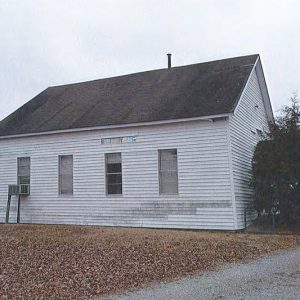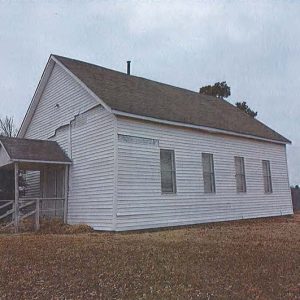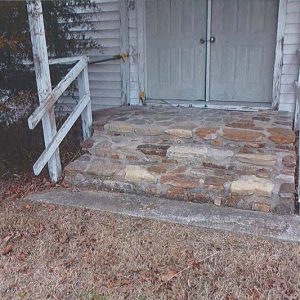calsfoundation@cals.org
Galatia Church
The Galatia Church is a one-room, wood-framed structure located southeast of the town of Norfork (Baxter County). Constructed circa 1900, it was listed on the National Register of Historic Places on September 8, 2020.
Although adjacent to the Galatia Church, the Galatia Cemetery was created several decades before the construction of the first church building on the site. Since its creation, the cemetery has grown to include private family areas as well as additional acreage. According to local oral tradition, the cemetery was in use by members of the Lackey family in the mid-nineteenth century. In February 1886, only three years before his death in 1889, Robert Lackey deeded ten acres of land for a church and cemetery to the Methodist Episcopal Church, South, as a donation. The land that Lackey deeded already included the family cemetery that would become the local community cemetery in the following years. In the years after the land was donated to the community, a small church was built just to the northwest of where the current church structure stands. The name Galatia seems to have been associated with the church and cemetery since its creation.
In local oral histories collected by members of the Galatia Cemetery Association, the first church was described as being down the hill from the current church. In a handwritten history of the Galatia Methodist Church held in the Methodist Church Archives at Hendrix College, Willie Ernestine Dwelle recounted that Ambrose Lane was the carpenter for the original church building. It was also stated that Lane hand-planed all of the wood that Henry Wood sawed for the first church building
The first church structure burned sometime before 1900, and the current church building was built farther up the hill, overlooking the cemetery. The building was used for church services as well as other community activities, including the meetings of a literary society, pie suppers, funerals, and other events. In newspaper accounts in the local Baxter Bulletin, it was also noted that the Galatia Church was used as a local schoolhouse, which was typical in the late nineteenth and early twentieth centuries. Also, it was noted in a flashback article in the Baxter Bulletin that the nearby town of Devero, which eventually was renamed Norfork, sent their students to the schoolhouse at Galatia in 1906, as the Devero community did not have a school.
The church’s membership continued to grow throughout the early twentieth century, and the congregation shared a pastor with the Methodist church in Norfork. After membership declined during the mid-1900s, the church was consolidated with the Norfork United Methodist Church during the 1970s. It appears from newspaper accounts and local histories that the current church was also used by the Church of Christ at the same time the Methodist congregation was using it.
The interior of the church consists of one large room with a small raised carpeted stage along the rear wall. The interior ceiling side sections are angled to create a roughly vaulted interior space. The walls and ceiling are covered with horizontal beadboard panels. Four large globe lights hang from the ceiling, and three ceiling fans help cool the interior. The floor is composed of wood with a central portion covered in carpet.
The Galatia Cemetery Association was created in 1978. This association began caring for the church and the surrounding cemetery. The North Arkansas Conference of the United Methodist Church deeded the property to the cemetery association in 1985. Soon after, Mauzee Pitchford, the president of the Galatia Cemetery Association, signed over the church building to the Galatia Church Association, a new organization that had formed to restore the church building.
During the mid-1980s, the building was restored for use. The roof and several internal supporting rafters were replaced, vinyl siding was added, and the front porch was covered. Also, the interior was painted, the floor and ceiling were repaired (and possibly partially replaced), new double entry doors were installed, and a wood stove was re-installed. The wood stove was later removed.
In 1993, a small group started the Galatia Christian Fellowship in the Galatia Church building. This group used the space until 1996, when it built a new church building on Jordan Road. After many years of standing empty, the church building was condemned by local officials in 2015.
In 2017, the Galatia Church property was added to Preserve Arkansas’s list of most endangered places as a symbol of the importance of the small rural churches throughout Arkansas that are in danger of disappearing. After receiving a grant from the Arkansas Historic Preservation Program, the vinyl siding was removed and wood windows based on the design of the original windows were installed in the building in late 2018 and early 2019.
For additional information:
Arkansas United Methodist Archives. Olin C. Bailey Library. Hendrix College, Conway, Arkansas.
Bradbury, Linda. “Old Galatia Church, Restored and Repurposed.” Baxter County History 50 (Fall-Winter 2024): 10.
Bradbury, Linda. ed. Old Galatia Church: Preserving Our Past. N.p.: 2018.
“Galatia Church.” National Register of Historic Places registration form. On file at Arkansas Historic Preservation Program, Little Rock, Arkansas. Online at http://www.arkansaspreservation.com/National-Register-Listings/PDF/BA0107.nr.pdf (accessed March 20, 2021).
Liles, Scott. “Group Hopes to Preserve Old Galatia Church.” Baxter Bulletin, August 6, 2019.
Callie Williams
Arkansas Historic Preservation Program
 Early Twentieth Century, 1901 through 1940
Early Twentieth Century, 1901 through 1940 Historic Preservation
Historic Preservation Religion
Religion Galatia Church
Galatia Church  Galatia Church
Galatia Church  Galatia Church
Galatia Church  Galatia Church
Galatia Church 



Comments
No comments on this entry yet.